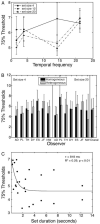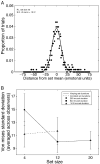Averaging facial expression over time
- PMID: 20053064
- PMCID: PMC2857387
- DOI: 10.1167/9.11.1
Averaging facial expression over time
Abstract
The visual system groups similar features, objects, and motion (e.g., Gestalt grouping). Recent work suggests that the computation underlying perceptual grouping may be one of summary statistical representation. Summary representation occurs for low-level features, such as size, motion, and position, and even for high level stimuli, including faces; for example, observers accurately perceive the average expression in a group of faces (J. Haberman & D. Whitney, 2007, 2009). The purpose of the present experiments was to characterize the time-course of this facial integration mechanism. In a series of three experiments, we measured observers' abilities to recognize the average expression of a temporal sequence of distinct faces. Faces were presented in sets of 4, 12, or 20, at temporal frequencies ranging from 1.6 to 21.3 Hz. The results revealed that observers perceived the average expression in a temporal sequence of different faces as precisely as they perceived a single face presented repeatedly. The facial averaging was independent of temporal frequency or set size, but depended on the total duration of exposed faces, with a time constant of approximately 800 ms. These experiments provide evidence that the visual system is sensitive to the ensemble characteristics of complex objects presented over time.
Figures









Similar articles
-
Ensemble crowd perception: a viewpoint-invariant mechanism to represent average crowd identity.J Vis. 2014 Jul 29;14(8):26. doi: 10.1167/14.8.26. J Vis. 2014. PMID: 25074904 Free PMC article.
-
Quantifying human sensitivity to spatio-temporal information in dynamic faces.Vision Res. 2014 Jul;100:78-87. doi: 10.1016/j.visres.2014.04.009. Epub 2014 Apr 28. Vision Res. 2014. PMID: 24784699
-
Seeing the mean: ensemble coding for sets of faces.J Exp Psychol Hum Percept Perform. 2009 Jun;35(3):718-34. doi: 10.1037/a0013899. J Exp Psychol Hum Percept Perform. 2009. PMID: 19485687 Free PMC article.
-
Adaptation reveals that facial expression averaging occurs during rapid serial presentation.J Vis. 2017 Jan 1;17(1):15. doi: 10.1167/17.1.15. J Vis. 2017. PMID: 28114490
-
Within-hemifield perceptual averaging of facial expressions predicted by neural averaging.J Vis. 2009 Mar 5;9(3):2.1-11. doi: 10.1167/9.3.2. J Vis. 2009. PMID: 19757941 Free PMC article.
Cited by
-
What is the Bandwidth of Perceptual Experience?Trends Cogn Sci. 2016 May;20(5):324-335. doi: 10.1016/j.tics.2016.03.006. Trends Cogn Sci. 2016. PMID: 27105668 Free PMC article. Review.
-
Limited evidence of hierarchical encoding in the cheerleader effect.Sci Rep. 2019 Jun 27;9(1):9329. doi: 10.1038/s41598-019-45789-6. Sci Rep. 2019. PMID: 31249339 Free PMC article.
-
Differential hemispheric and visual stream contributions to ensemble coding of crowd emotion.Nat Hum Behav. 2017;1:828-842. doi: 10.1038/s41562-017-0225-z. Epub 2017 Oct 9. Nat Hum Behav. 2017. PMID: 29226255 Free PMC article.
-
Seeing a Face in a Crowd of Emotional Voices: Changes in Perception and Cortisol in Response to Emotional Information across the Senses.Brain Sci. 2019 Jul 25;9(8):176. doi: 10.3390/brainsci9080176. Brain Sci. 2019. PMID: 31349644 Free PMC article.
-
Gender differences in crowd perception.Front Psychol. 2015 Sep 2;6:1300. doi: 10.3389/fpsyg.2015.01300. eCollection 2015. Front Psychol. 2015. PMID: 26388805 Free PMC article.
References
-
- Albrecht A, Scholl B. Perceptually averaging in a continuous world: Extracting statistical summary representations over times. Psychological Science. in press. - PubMed
-
- Ariely D. Seeing sets: Representation by statistical properties. Psychological Science. 2001;12:157–162. - PubMed
-
- Beck J. Textural segmentation, 2nd-order statistics, and textural elements. Biological Cybernetics. 1983;48:125–130. - PubMed
-
- Blake R, Lee SH. The role of temporal structure in human vision. Behavioural Cognitive Neuroscience Review. 2005;4:21–42. - PubMed
Publication types
MeSH terms
Grants and funding
LinkOut - more resources
Full Text Sources

